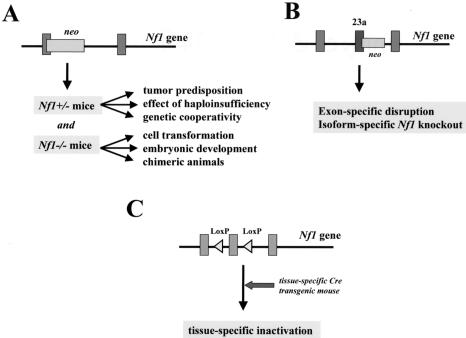Figure 4.
Strategies for Nf1 mouse modeling. (A) Traditional Nf1+/- mice were generated in which one allele of the murine Nf1 gene is inactivated by the insertion of a neomycin (neo) cassette. Nf1 +/- mice can be studied for tumor predisposition, effects of haploinsufficiency, and genetic cooperativity. In addition, Nf1 +/- mice can be intercrossed to generate Nf1-/- mice to analyze the effect of neurofibromin loss on cell transformation and embryonic development. Nf1-/- cells can be used to generate chimeric Nf1 mice. (B) Nf1 mutant mice can also be generated in which specific exons are deleted. In this regard, the effect of ablation of a particular Nf1 alternatively spliced exon can be studied. Alternatively, mice can be generated in which a stop codon is inserted into the alternatively spliced exon to ablate Nf1 expression in tissues that express that particular Nf1 isoform. (C) Tissue-specific Nf1 inactivation can be accomplished by the use of Cre/LoxP technology. Briefly, LoxP recombinatorial sequences are inserted into noncoding regions of the Nf1 gene to produce phenotypically normal Nf1flox mice. Tissue-specific inactivation is mediated by the expression of the bacteriophage Cre recombinase from a tissue-specific promoter (e.g., synapsin-I promoter).

